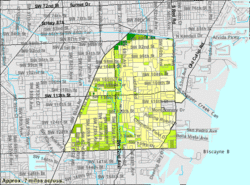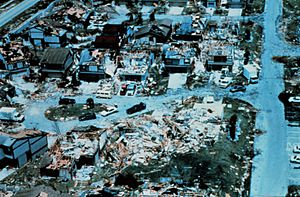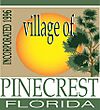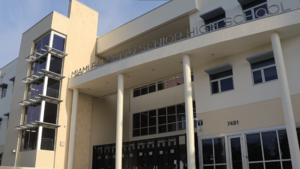Pinecrest, Florida facts for kids
Quick facts for kids
Pinecrest, Florida
|
||
|---|---|---|
| Village of Pinecrest | ||
|
||

U.S. Census Bureau map showing village boundaries
|
||
| Country | ||
| State | ||
| County | ||
| Incorporated | March 12, 1996 | |
| Government | ||
| • Type | Council-Manager | |
| Area | ||
| • Total | 7.54 sq mi (19.52 km2) | |
| • Land | 7.45 sq mi (19.30 km2) | |
| • Water | 0.09 sq mi (0.23 km2) 0.13% | |
| Elevation | 3 ft (1 m) | |
| Population
(2020)
|
||
| • Total | 18,388 | |
| • Density | 2,467.86/sq mi (952.88/km2) | |
| Time zone | UTC-5 (EST) | |
| • Summer (DST) | UTC-4 (EDT) | |
| ZIP Code |
33156
|
|
| Area code(s) | 305, 786, 645 | |
| FIPS code | 12-56625 | |
| GNIS feature ID | 1764896 | |
Pinecrest is a lovely suburban village located in Miami-Dade County, Florida, United States. It's part of the larger Miami metropolitan area in South Florida. In 2020, about 18,388 people lived there.
Pinecrest is run by a five-member village council and uses a special type of government called a council-manager system. This means elected officials make decisions, and a professional manager handles daily operations. The area's ZIP code, 33156, is known for being one of the wealthiest in the U.S. Also, homes in Pinecrest are quite expensive, with a typical listing price of $4,300,000 in recent years. This makes it one of the priciest places to buy a home in Florida.
Contents
History of Pinecrest
Early Days and Development
Back in the 1900s, a famous Miami pioneer named Henry Flagler used land in the Pinecrest area. He was a railroad tycoon, meaning he built a huge railroad system. This land was a base for building the Overseas Railroad that went all the way to the Florida Keys.
In the 1930s, the area started to grow more. A popular tourist attraction called Parrot Jungle and Gardens opened. It was founded in 1936 by Franz and Louise Scherr. This place became famous, even hosting visitors like Winston Churchill.
Parrot Jungle and Pinecrest Gardens
Franz Scherr, who owned a general store, wanted to create a place where birds could "fly free." He rented 20 acres (about 8 hectares) of hammock land for just $25 a year. A hammock is a type of forest with rich soil.
Parrot Jungle was built as a winding nature trail. It went through the natural coral rock and hammock land. The entrance was on Red Road. It opened on December 20, 1936, with about 100 visitors. They paid 25 cents each to see the birds and hear Scherr talk about nature. Over the years, millions of people visited Parrot Jungle.
In 2002, the Village of Pinecrest bought the Parrot Jungle site. They wanted to turn it into a public park. On March 8, 2003, it officially opened as Pinecrest Gardens, a new village park. The original Parrot Jungle attraction later moved to Watson Island and is now called Parrot Jungle Island.
Another interesting place was the Miami Serpentarium. This tourist spot showed snakes, lizards, and other reptiles and amphibians. It was on US 1 for many years before closing in the mid-1980s.
Growth and Challenges
During the 1950s and 1960s, the area really grew. Many ranch-style houses were built on large 1-acre (about 0.4 hectare) lots. This helped create the community's green and spacious feel.

In August 1992, Pinecrest and the surrounding areas were hit very hard by Hurricane Andrew. Many homes and businesses were destroyed. But over the next few years, the community slowly rebuilt itself.
Becoming a Village
Because of fast growth and local issues in the 1990s, residents decided to form their own village. Evelyn Greer Langlieb and Gary C. Matzner led this effort. The Village of Pinecrest officially became a town on March 12, 1996.
Evelyn Greer was elected as the first mayor. She served two terms, and then Gary Matzner became mayor in 2004. The first village council, along with the Village Manager and Village Clerk, helped create important services. These included police, parks, recreation, building services, and public works.
Geography of Pinecrest
Pinecrest is located about 11 miles (18 km) southwest of downtown Miami. Its exact location is 25°40′N 80°18′W / 25.667°N 80.300°W. U.S. Route 1, also known as Pinecrest Parkway, forms the western edge of the village.
Pinecrest shares borders with several other communities:
- Coral Gables is to the east.
- South Miami is to the north.
- Glenvar Heights is to the northwest.
- Kendall is to the west.
- Palmetto Bay is to the south.
The village covers a total area of about 7.54 square miles (19.52 km2). Most of this area, 7.45 square miles (19.30 km2), is land. A small part, 0.09 square miles (0.23 km2), is water.
Population and People
| Historical population | |||
|---|---|---|---|
| Census | Pop. | %± | |
| 2000 | 19,055 | — | |
| 2010 | 18,223 | −4.4% | |
| 2020 | 18,388 | 0.9% | |
| U.S. Decennial Census | |||
As of the 2020 United States census, Pinecrest had 18,388 people living in 5,986 households. About 4,824 of these were families.
Here's a quick look at the population:
- 4.8% of the people were under 5 years old.
- 27.5% were under 18 years old.
- 17.8% were 65 years or older.
- 46.3% of the population were female.
The average income for a household in Pinecrest was $166,801. About 7.7% of the population lived below the poverty line. This means they had incomes below a certain level set by the government.
Most homes in Pinecrest are very connected:
- 97.9% of households had a computer.
- 95.6% of households had a fast internet connection (broadband).
About 29.7% of the people living in Pinecrest were born in another country. There were also 425 veterans, who are people who have served in the military.
Getting Around Pinecrest
Pinecrest has public transportation options to help people travel.
- The Metrobus system serves the entire area.
- The Miami Metrorail train system has stations nearby:
- Dadeland North (located at SW 70th Avenue and U.S. 1)
- Dadeland South (located at Dadeland Boulevard and U.S. 1)
Schools and Learning
Pinecrest is part of the Miami-Dade County Public Schools system. This means there are public schools for students of all ages.
Public Schools
- Elementary Schools:
- Pinecrest Elementary School (opened in 1954)
- Palmetto Elementary School
- Howard Drive Elementary School (located in Palmetto Bay)
- Middle Schools:
- Palmetto Middle School
- High Schools:
Private Schools
Pinecrest also has several private schools:
- Bet Shira Congregation
- Gulliver Preparatory
- Kendall United Methodist
- Pinecrest Presbyterian
- St. Louis Covenant School
- Temple Beth Am
The Miami-Dade Public Library System has a branch right in Pinecrest, offering books and resources for everyone.
There was also a weekend school for Japanese citizens called Miami Hoshuko. It used to hold classes at the Kendall United Methodist Church, which is now in Pinecrest.
Local News and Media
The Village of Pinecrest has its own newspaper called The Pinecrest Tribune. It comes out every two weeks and is part of Miami Community Newspapers. Residents can also get local radio and television from the larger Miami area.
Images for kids
-
Damage from Hurricane Andrew in 1992 in the area
See also
 In Spanish: Pinecrest para niños
In Spanish: Pinecrest para niños





